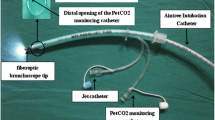Abstract
The Trachway video intubating stylet device facilitates the visualization of the airways of patients from the tip of an endotracheal tube (ETT) during intubation. The major limitations of Trachway are the restricted view due to secretions and the risk of a prolonged apnea during intubation. We conducted a bench study to verify the performance of an alternative, easily applicable airway device that allows better visualization of trackways during Trachway-assisted intubation and prevents the detrimental effects of apnea-related hypoxia. We conducted a bench study to thoroughly evaluate the oral-secretion-elimination ability of a newly designed oxygen delivery device (ODD) to improve vocal-cord visualization using the three commonly used ETT sizes (i.e., 7, 7.5, and 8 mm). Moreover, we measured the fraction of inspired oxygen (FiO2) under different, continuous oxygen-flow supplies (1–10 L/min) during intubation. Each condition was analyzed for a 2 min video-stylet-intubation period. The supplemental oxygen flow and FiO2 fraction achieved using our ODD were higher, and smaller ETTs exhibited better secretion elimination. The ODD, which can be easily coupled with Trachway stylets, enabled high-quality visualization during oxygen flows of 6–8 L/min, and higher FiO2 fractions were achieved at higher oxygen flow rates. The use of the ODD improved the visualization of the airways during video stylet-assisted intubations using the additional FiO2 supply. The ODD developed in this study improves the visualization of airways with Trachway stylets and enhances the safety of intubation.






Similar content being viewed by others
Data availability
Not applicable.
Code availability
Not applicable.
References
Liem EB, Bjoraker DG, Gravenstein D. New options for airway management: intubating fibreoptic stylets. Br J Anaesth. 2003;91(3):408–18.
Tseng KY, et al. A comparison of Trachway intubating stylet and airway scope for tracheal intubation by novice operators: a manikin study. Kaohsiung J Med Sci. 2012;28(8):448–51.
Sun DA, et al. The GlideScope video laryngoscope: randomized clinical trial in 200 patients. Br J Anaesth. 2005;94(3):381–4.
Nouruzi-Sedeh P, Schumann M, Groeben H. Laryngoscopy via Macintosh blade versus GlideScope: success rate and time for endotracheal intubation in untrained medical personnel. Anesthesiology. 2009;110(1):32–7.
Smith CE, et al. The complexity of tracheal intubation using rigid fiberoptic laryngoscopy (WuScope). Anesth Analg. 1999;89(1):236–9.
Fu ES, et al. Supplemental oxygen impairs detection of hypoventilation by pulse oximetry. Chest. 2004;126(5):1552–8.
Nimmagadda U, Salem MR, Crystal GJ. Preoxygenation: physiologic basis, benefits, and potential risks. Anesth Analg. 2017;124(2):507–17.
Fisher JA, Iscoe S, Duffin J. Sequential gas delivery provides precise control of alveolar gas exchange. Respir Physiol Neurobiol. 2016;225:60–9.
Pavlov I, Medrano S, Weingart S. Apneic oxygenation reduces the incidence of hypoxemia during emergency intubation: a systematic review and meta-analysis. Am J Emerg Med. 2017;35(8):1184–9.
Vukovic AA, et al. Apneic oxygenation reduces hypoxemia during endotracheal intubation in the pediatric emergency department. Am J Emerg Med. 2019;37(1):27–32.
Wong DT, et al. The effectiveness of apneic oxygenation during tracheal intubation in various clinical settings: a narrative review. Can J Anaesth. 2017;64(4):416–27.
Teller LE, et al. Pharyngeal insufflation of oxygen prevents arterial desaturation during apnea. Anesthesiology. 1988;69(6):980–2.
Taha SK, et al. Nasopharyngeal oxygen insufflation following pre-oxygenation using the four deep breath technique. Anaesthesia. 2006;61(5):427–30.
Dodds MW, Johnson DA, Yeh CK. Health benefits of saliva: a review. J Dent. 2005;33(3):223–33.
Acknowledgements
The authors thank the Biostatistics Task Force at Taipei Veterans General Hospital for their statistical analysis support.
Funding
Not applicable.
Author information
Authors and Affiliations
Contributions
Protocol development: HYW, CKT; obtaining data for analysis: HYW, KHC; data extraction: CL, MTL; data analysis: CCC, CL, MTL; interpretation of analysis: CKT; article drafting: HYW; final manuscript review: CKT.
Corresponding author
Ethics declarations
Conflict of interest
Not applicable.
Ethical approval
The proposed article reports an experiment to investigate the ODD efficacy in eliminating oral saliva bubbles in mannequin-head–test-lung ventilator system. Therefore, because the study did not involve any human participants or animal subjects, an ethics approval statement has not been included in the manuscript..
Additional information
Publisher's Note
Springer Nature remains neutral with regard to jurisdictional claims in published maps and institutional affiliations.
Supplementary Information
Below is the link to the electronic supplementary material.
Supplementary file1 (AVI 17014 kb)
Rights and permissions
About this article
Cite this article
Wang, HY., Lin, C., Chen, CC. et al. Improvement in vocal-cord visualization with Trachway video intubating stylet using direct oxygen flow and effective analysis of the fraction of inspired oxygen: a bench study. J Clin Monit Comput 36, 1723–1730 (2022). https://doi.org/10.1007/s10877-022-00818-0
Received:
Accepted:
Published:
Issue Date:
DOI: https://doi.org/10.1007/s10877-022-00818-0




